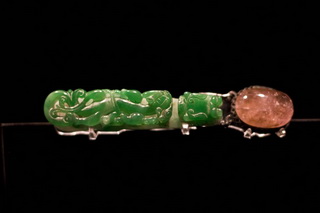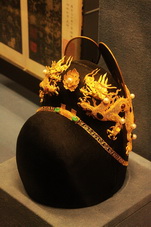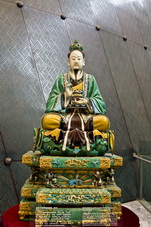 The Capital Museum, located at 16 Fuxingmenwai Avenue, Xicheng District, Beijing, was opened in 1981 while the present building was built in the late 90s. The Capital Museum today contains over 200,000 cultural relics in its collection, only a small fraction of it are exhibited, and a significant percentage of the museum's art collection came from artifacts unearthed in Beijing.
The Capital Museum, located at 16 Fuxingmenwai Avenue, Xicheng District, Beijing, was opened in 1981 while the present building was built in the late 90s. The Capital Museum today contains over 200,000 cultural relics in its collection, only a small fraction of it are exhibited, and a significant percentage of the museum's art collection came from artifacts unearthed in Beijing.  The Capital Museum was established in 1981 with a collection of some 83,000 objects. Although initially the Museum pales in comparison to the visitors received in other major art museums in Beijing, such as the Palace Museum in the Forbidden City, the National Museum of China and the National Art Museum of China; it has since then became one of the leading cultural institutions in the city, with the first five months of 2007 receiving more than 166,000 visitors.
The Capital Museum was established in 1981 with a collection of some 83,000 objects. Although initially the Museum pales in comparison to the visitors received in other major art museums in Beijing, such as the Palace Museum in the Forbidden City, the National Museum of China and the National Art Museum of China; it has since then became one of the leading cultural institutions in the city, with the first five months of 2007 receiving more than 166,000 visitors.
The present Capital Museum's building's massive roof and the gradient  at the entrance square was influenced by the design from ancient Chinese architecture, and the stone-made exterior wall was meant to symbolize imagery of the city walls and towers in ancient China. A piece of danbi (a massive stone carved with images of dragon, phoenix and imperial artifacts) is embedded on the ground in front of the north gate of the museum, whereas a decorative archway from the Ming Dynasty is set in the reception hall in which shows the central axis feature that are commonly seen in Chinese architecture. The Bronze Exhibition Hall, which has an oval-shape, was also meant to symbolize the unearthing of ancient relics by its slanting design in which extends from the ground to the exterior of the museum.
at the entrance square was influenced by the design from ancient Chinese architecture, and the stone-made exterior wall was meant to symbolize imagery of the city walls and towers in ancient China. A piece of danbi (a massive stone carved with images of dragon, phoenix and imperial artifacts) is embedded on the ground in front of the north gate of the museum, whereas a decorative archway from the Ming Dynasty is set in the reception hall in which shows the central axis feature that are commonly seen in Chinese architecture. The Bronze Exhibition Hall, which has an oval-shape, was also meant to symbolize the unearthing of ancient relics by its slanting design in which extends from the ground to the exterior of the museum.



 China Tours
China Tours Tibet Tours
Tibet Tours China Theme Tours
China Theme Tours Off The Beaten Track
Off The Beaten Track Yangtze Cruises
Yangtze Cruises China Trip Planner
China Trip Planner Travel Agents
Travel Agents